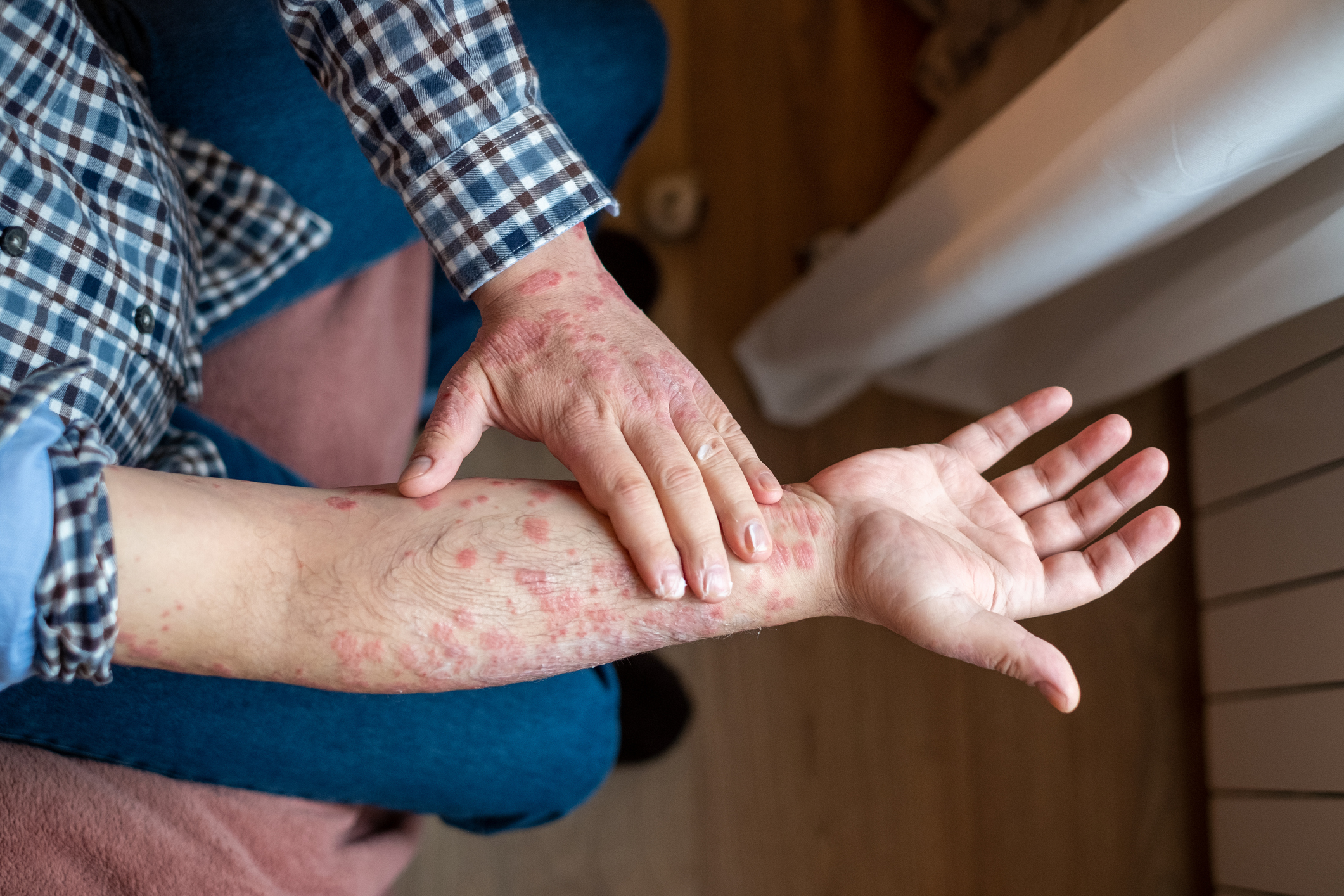You probably already know that eczema is an inflammatory skin disease. But what exactly does that mean? What are the causes of this condition? What role does the immune system play in eczema?
Eczema symptoms
The key symptom of eczema is a red, patchy skin rash that itches intensely. It actually starts not as a rash but as an itch which develops into a rash when scratched. For this reason, it’s sometimes called “the itch that rashes,” rather than “the rash that itches.”
The term “eczema” does not refer to one single disease but serves as an umbrella term for conditions that involve inflamed skin. The most common form of eczema is called atopic dermatitis. In fact, atopic dermatitis accounts for such a high percentage of cases that many people use “eczema” and “atopic dermatitis” interchangeably. The condition’s many signs include raw skin, oozing blisters, discoloration of the skin, a red rash, dry and scaly patches, warm and swollen skin, and bumps that leak fluid. In infants and young children, the rash frequently appears on the cheeks, around the mouth, on the forehead or scalp, or sometimes on the arms or legs. In older children, the most common rash sites are the insides of the elbows and backs of the knees, the neck, the wrists, and the ankles. Adults usually get the condition on their hands and around their eyes.
People who live for a long time with atopic dermatitis often develop thickened skin from repeated scratching and rubbing. Atopic dermatitis can also take a psychological toll, contributing to social isolation, anxiety, and depression.
The second most common type of eczema is called contact dermatitis. As its name implies, it is an itchy rash that develops when the skin makes contact with a substance that irritates it. Its outward symptoms are similar to those of atopic dermatitis…an angry rash with itching and swelling, occasionally with blisters and sores that leak fluid. Contact dermatitis often appears on the hands but can show up on any part of the body. If the irritating substance is not contacted frequently, the rash may appear only occasionally.
How eczema develops
Our immune systems are amazing. When we’re injured or when foreign substances enter our bodies, an incredibly sophisticated series of actions takes place to stamp out the threat and clear away dead or damaged tissue. One of the crucial components of this process is the sorting out of threats from harmless substances. For example, our immune systems don’t normally mount a response to the consumption of food, even though it’s a foreign substance entering the body, while a sliver in the skin or harmful bacteria in the bloodstream will indeed trigger an inflammatory reaction.
Unfortunately, this ability to know friend from foe is sometimes impaired, and the immune system mounts an attack against a benign substance. For example, tree pollen is not inherently harmful, nor are peanuts, animal dander, or latex. But people whose immune systems are hypersensitive to them treat these substances as dangerous and worthy of a robust defensive reaction. Eczema is one of these hypersensitivity disorders.
Here’s how things go wrong. An important component of your immune system are dendritic cells, which you might think of as the intelligence units of the system. Their job is to capture and interrogate invaders so that they’ll be recognized by the immune system if they ever appear again, creating a biological profile…a kind of “Wanted” poster, for future reference.
Imagine, for example, the first time a child is exposed to the common cold. Dendritic cells share the identifying features of the virus with the rest of the immune system so that it will be ready with a rapid response the next time the child is exposed. That happens through a chain of biochemical reactions involving different types of cells that brings word of the invader to a group of protective antibody proteins called immunoglobulin e (IgE) cells. Those IgE cells will then lie in wait, sometimes for years, to see if the invader dares make another appearance. If it does, the IgE cells immediately flood the area with pro-inflammatory substances. This encounter also stimulates production of even more IgE cells so that subsequent invasions are met with an even more robust response.
In people with eczema, this process is impaired. For some reason, the dendritic cells have mistaken an innocuous guest for an enemy. For example, even though pet dander should be viewed as harmless, the first time a child was exposed to it the dendritic cells passed along word to the IgE cells that they must always be ready to fight pet dander any time it appeared. When the IgE cells later encounter pet dander, they launch an inflammatory assault that causes a skin flare-up (People with eczema tend to have more IgE cells than others, and there appears to be a genetic component to the condition).
It would be bad enough if that were all there were to it. But eczema has a kind of built-in feature that makes it very stubborn. Its rash is extremely itchy, and hardly anyone can avoid the temptation to scratch at it. But when you do, you destroy the outer layer of the skin, called the epidermis. The epidermis usually acts as a protective barrier, keeping out irritants. But when you break it down, you’re allowing the very same substances that triggered the reaction to get down into the deeper layers of the skin. This in turn prompts additional immune response, inflammation, and itching. Instead of tapering off, the immune response continues on, along with a constant low-level inflammation that persists even when no rash is visible.


